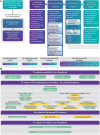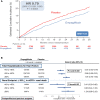The year in cardiovascular medicine 2021: heart failure and cardiomyopathies
- PMID: 34974611
- PMCID: PMC9383181
- DOI: 10.1093/eurheartj/ehab887
The year in cardiovascular medicine 2021: heart failure and cardiomyopathies
Abstract
In the year 2021, the universal definition and classification of heart failure (HF) was published that defines HF as a clinical syndrome with symptoms and/or signs caused by a cardiac abnormality and corroborated by elevated natriuretic peptide levels or objective evidence of cardiogenic congestion. This definition and the classification of HF with reduced ejection fraction (HFrEF), mildly reduced, and HF with preserved ejection fraction (HFpEF) is consistent with the 2021 ESC Guidelines on HF. Among several other new recommendations, these guidelines give a Class I indication for the use of the sodium-glucose co-transporter 2 (SGLT2) inhibitors dapagliflozin and empagliflozin in HFrEF patients. As the first evidence-based treatment for HFpEF, in the EMPEROR-Preserved trial, empagliflozin reduced the composite endpoint of cardiovascular death and HF hospitalizations. Several reports in 2021 have provided novel and detailed analyses of device and medical therapy in HF, especially regarding sacubitril/valsartan, SGLT2 inhibitors, mineralocorticoid receptor antagonists, ferric carboxymaltose, soluble guanylate cyclase activators, and cardiac myosin activators. In patients hospitalized with COVID-19, acute HF and myocardial injury is quite frequent, whereas myocarditis and long-term damage to the heart are rather uncommon.
Keywords: Activators of soluble guanylate cyclase; Angiotensin receptor–neprilysin inhibitors; Artificial intelligence; Biomarkers; Device therapy; Epidemiology; Heart failure; Imaging; Pharmacotherapy; SGLT-2 inhibitor.
© The Author(s) 2022. Published by Oxford University Press on behalf of European Society of Cardiology. All rights reserved. For permissions, please e-mail: journals.permissions@oup.com.
Figures





References
-
- Figtree GA, Broadfoot K, Casadei B, Califf R, Crea F, Drummond GR, et al. A call to action for new global approaches to cardiovascular disease drug solutions. Eur Heart J 2021;42:1464–1475. - PubMed
-
- Bozkurt B, Coats AJS, Tsutsui H, Abdelhamid CM, Adamopoulos S, Albert N, et al. Universal definition and classification of heart failure: a report of the Heart Failure Society of America, Heart Failure Association of the European Society of Cardiology, Japanese Heart Failure Society and Writing Committee of the Universal Definition of Heart Failure: endorsed by the Canadian Heart Failure Society, Heart Failure Association of India, Cardiac Society of Australia and New Zealand, and Chinese Heart Failure Association. Eur J Heart Fail 2021;23:352–380. - PubMed
-
- McDonagh TA, Metra M, Adamo M, Gardner RS, Baumbach A, Bohm M, et al. ESC Guidelines for the diagnosis and treatment of acute and chronic heart failure. Eur Heart J 2021;42:3599–3726. - PubMed
-
- Cleland JGF, Pfeffer MA, Clark AL, Januzzi JL, McMurray JJV, Mueller C, et al. The struggle towards a Universal Definition of Heart Failure—how to proceed? Eur Heart J 2021;42:2331–2343. - PubMed
-
- Seferovic PM, Vardas P, Jankowska EA, Maggioni AP, Timmis A, Milinkovic I, et al. The heart failure association atlas: heart failure epidemiology and management statistics 2019. Eur J Heart Fail 2021;23:906–914. - PubMed
MeSH terms
Substances
LinkOut - more resources
Full Text Sources
Medical
Research Materials
Miscellaneous

